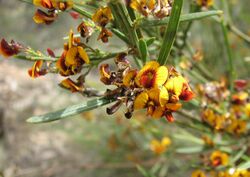Biology:Daviesia leptophylla
| Narrow-leaf bitter-pea | |
|---|---|

| |
| Daviesia leptophylla in Enfield State Park | |
| Scientific classification | |
| Kingdom: | Plantae |
| Clade: | Tracheophytes |
| Clade: | Angiosperms |
| Clade: | Eudicots |
| Clade: | Rosids |
| Order: | Fabales |
| Family: | Fabaceae |
| Subfamily: | Faboideae |
| Genus: | Daviesia |
| Species: | D. leptophylla
|
| Binomial name | |
| Daviesia leptophylla A.Cunn. ex G.Don[1]
| |
| Synonyms[1] | |
| |
Daviesia leptophylla, commonly known as narrow-leaf bitter-pea,[2] is a species of flowering plant in the family Fabaceae and is endemic to south-eastern continental Australia. It is a broom-like, multi-stemmed shrub with dull, yellowish-green, linear phyllodes and bright yellow flowers with maroon markings.
Description
Daviesia leptophylla is a glabrous, broom-like, multi-stemmed shrub that typically grows to a height of up to about 2 m (6 ft 7 in) high or rarely, tree-like to 5 m (16 ft) wide. The phyllodes are scattered along the branchlets, linear, yellowish-green, up to 90 mm (3.5 in) long and 6 mm (0.24 in) wide. The flowers are borne in leaf axils usually on two racemes of five to ten flowers, the racemes on peduncles 1.3–5.0 mm (0.051–0.197 in) long, the rachis 1.5–6.0 mm (0.059–0.236 in) long, each flower on a pedicel 1.0–2.5 mm (0.039–0.098 in) long. The sepals are 3.4–4.7 mm (0.13–0.19 in) long and joined at the base, the upper two joined for most of their length and the lower three triangular and 0.50–0.75 mm (0.020–0.030 in) long. The standard petal is broadly elliptic with a notched centre, 6.0–6.5 mm (0.24–0.26 in) long and bright yellow with a maroon base and intensely yellow centre, the wings 5.0–6.0 mm (0.20–0.24 in) long and dark red with yellow edges, and the keel 4.0–4.5 mm (0.16–0.18 in) long and dark red. Flowering occurs from August to December and the fruit is flattened triangular pod 5–10 mm (0.20–0.39 in) long.[2][3][4][5][6]
Taxonomy
Daviesia leptophylla was first formally described in 1832 by George Don in his book A General History of Dichlamydeous Plants from an unpublished manuscript by Allan Cunningham.[7][8] The specific epithet (leptophylla) means "slender-leaved".[9]
Distribution and habitat
Narrow-leaf bitter-pea grows in shrubland or forest, mostly on the slopes and tablelands at altitudes up to 1,400 m (4,600 ft), from Wellington in New South Wales through the Australian Capital Territory and central Victoria to the south-east of South Australia.[2][3][4][5]
References
- ↑ 1.0 1.1 "Daviesia leptophylla". Australian Plant Census. https://biodiversity.org.au/nsl/services/apc-format/display/82967.
- ↑ 2.0 2.1 2.2 Jeanes, Jeff A.. "Daviesia leptophylla". Royal Botanic Gardens Victoria. https://vicflora.rbg.vic.gov.au/flora/taxon/06900c86-5d37-4559-bc92-bd49f509d268.
- ↑ 3.0 3.1 Crisp, Michael D.; Cayzer, Lindy; Chandler, Gregory T.; Cook, Lyn G. (2017). "A monograph of Daviesia (Mirbelieae, Faboideae, Fabaceae)". Phytotaxa 300 (1): 117–120. doi:10.11646/phytotaxa.300.1.1.
- ↑ 4.0 4.1 Crisp, Michael D.. "Daviesia leptophylla". Royal Botanic Garden Sydney. https://plantnet.rbgsyd.nsw.gov.au/cgi-bin/NSWfl.pl?page=nswfl&lvl=sp&name=Daviesia~leptophylla.
- ↑ 5.0 5.1 "Daviesia leptophylla". State Herbarium of South Australia. http://www.flora.sa.gov.au/cgi-bin/speciesfacts_display.cgi?form=speciesfacts&name=Daviesia_leptophylla.
- ↑ Wood, Betty. "Daviesia leptophylla". Lucid keys. https://apps.lucidcentral.org/plants_se_nsw/text/entities/daviesia_leptophylla.htm.
- ↑ "Daviesia leptophylla". APNI. https://id.biodiversity.org.au/instance/apni/500366.
- ↑ Don, George (1832). A General History of Dichlamydeous Plants. 2. p. 125. https://www.biodiversitylibrary.org/item/62428#page/139/mode/1up. Retrieved 21 February 2022.
- ↑ Sharr, Francis Aubi; George, Alex (2019). Western Australian Plant Names and Their Meanings (3rd ed.). Kardinya, WA: Four Gables Press. p. 238. ISBN 9780958034180.
Wikidata ☰ Q5241754 entry
 |

